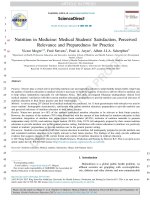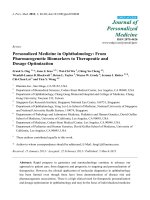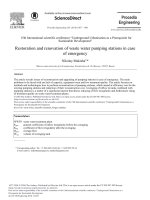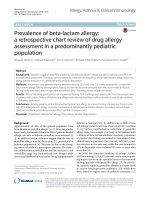Pediatric emergency medicine trisk 329
Bạn đang xem bản rút gọn của tài liệu. Xem và tải ngay bản đầy đủ của tài liệu tại đây (221.59 KB, 4 trang )
FIGURE 68.6 A characteristic well-demarcated erythematous circular plaque with a dusky
center seen with a fixed drug eruption. (Reprinted with permission from Somolinos AL, Grant
LM, Goldsmith LA, et al. VisualDx: Essential Dermatology in Pigmented Skin . Philadelphia,
PA: Lippincott Williams & Wilkins; 2011.)
FIGURE 68.7 This erythematous oval plaque occurred at the identical site where it occurred
the last time this patient was exposed to a sulfonamide antibiotic. (Reprinted with permission
from Goodheart HP. Goodheart’s Photoguide of Common Skin Disorders . 2nd ed. Philadelphia,
PA: Lippincott Williams & Wilkins; 2003.)
Erythema Multiforme
The lesions of EM have a classic target appearance, which appears as a welldefined round macule or papule with three distinct zones: two concentric rings
around a dusky, bullous, or crusted center ( Fig. 68.8A,B ). The lesions are
symmetrically distributed and favor the distal extremities, especially the upper
extremities. Mucous membrane lesions can be seen in up to half of cases. Bullous
lesions rupture easily, leaving swelling and crusting ( Fig. 68.9 ). EM lesions are
fixed, with individual lesions lasting approximately 7 days. Systemic symptoms
of malaise, low-grade fever, myalgias, or arthralgias may be present.
EM is a hypersensitivity reaction most often secondary to an infectious trigger.
EM has been associated with many infectious agents, including bacterial, viral,
fungal, and parasitic infections. Herpes simplex virus 1 and 2 and Mycoplasma
are the most common infectious triggers. Medications may be a cause of EM,
most commonly sulfonamides, antiepileptic medications, and antibiotics.
FIGURE 68.8 A, B: Classic target lesions seen in erythema multiforme with three distinct
zones. (A: Reproduced with permission from Roche Laboratories. Sauer GC, Hall JC. Manual
of Skin Diseases . 7th ed. Philadelphia, PA: Lippincott-Raven, 1996. B: Reprinted with
permission from Somolinos AL, Grant LM, Goldsmith LA, et al. VisualDx: Essential
Dermatology in Pigmented Skin . Philadelphia, PA: Lippincott Williams & Wilkins, 2011.)
EM is often confused for urticaria or SJS. EM can be distinguished from the
transient and pruritic lesions of urticaria because of the classic target appearance
of lesions that are fixed for several days. As discussed further below, SJS is a
severe drug eruption that has lesions that are often confused for the targetoid
lesions of EM, but they lack the characteristic three zones. Furthermore, in SJS,
two or more mucous membranes are typically involved with blisters, erosions,
and crusting.
EM is a self-limited reaction resolving within 2 to 3 weeks. Because of its
frequent association with herpes simplex virus, patients are often treated with
acyclovir. If a medication trigger is suspected, then stopping the medication will
help with resolution. Antihistamines can offer symptomatic relief.
FIGURE 68.9 Erosions on the lips with target lesions on the hands. (Reprinted with permission
from Somolinos AL, Grant LM, Goldsmith LA, et al. VisualDx: Essential Dermatology in
Pigmented Skin . Philadelphia, PA: Lippincott Williams & Wilkins; 2011.)
Stevens–Johnson Syndrome/Toxic Epidermal Necrolysis
SJS and toxic epidermal necrolysis (TEN) are clinically similar, but exist in a
spectrum distinguished by the degree of skin involvement. SJS involves <10% of
body surface area; TEN involves >30% of body surface area; and 10% to 30%
body surface area involvement is considered SJS/TEN overlap.
A prodrome of fever and constitutional symptoms (malaise, headache, sore
throat, myalgias, arthralgias) sometimes precedes the onset of cutaneous lesions.
Erythematous and purpuric macules start on the face and trunk and spread over
hours to a few days to become more confluent and bullous. Tender erosions
remain after the bullae rupture ( Fig. 68.10 ). As the erythematous macules
develop dusky centers indicating epidermal necrosis, they can have a targetoid
appearance but lack the classic three zones seen in the target lesions of EM.
Gentle lateral pressure to an area of macular erythema causes the epidermis to
sheer off, known as the Nikolsky sign. Postinflammatory dyspigmentation is
common.
Mucous membrane involvement can precede cutaneous involvement by 1 to 2
days. Two or more mucosal surfaces are usually involved, while any epithelial









